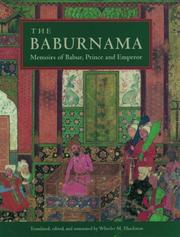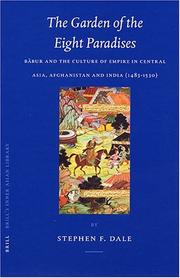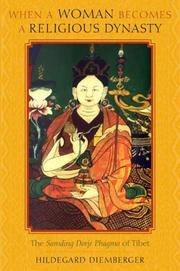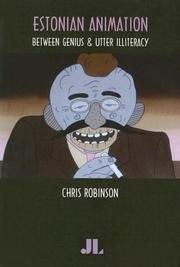| Listing 1 - 10 of 14 | << page >> |
Sort by
|
Book
ISBN: 9786054336760 Year: 2012 Publisher: Konya : Nüve Kültür Merkezi,
Abstract | Keywords | Export | Availability | Bookmark
 Loading...
Loading...Choose an application
- Reference Manager
- EndNote
- RefWorks (Direct export to RefWorks)
Book
ISBN: 3533027929 Year: 1979 Volume: 4/1979 Publisher: Heidelberg : Carl Winter,
Abstract | Keywords | Export | Availability | Bookmark
 Loading...
Loading...Choose an application
- Reference Manager
- EndNote
- RefWorks (Direct export to RefWorks)

ISBN: 0195096711 Year: 1996 Publisher: Washington, D.C. : Freer Gallery of Art,
Abstract | Keywords | Export | Availability | Bookmark
 Loading...
Loading...Choose an application
- Reference Manager
- EndNote
- RefWorks (Direct export to RefWorks)
Babur, Zahir al-Din, --- Mogul Empire --- Empire moghol --- History --- Histoire --- Babur Emperor of Hindustan --- Bābur, Ẓahīr al-Dīn, --- Babur, --- Zahīr al-Dīn Muḥammad, --- Muḥammad Bābar, Ẓahīr al-Dīn, --- Zakhir ad-Din Mukhammed Babur, --- Babur, Zakhir ad-Din Mukhammed, --- Zakhiriddin Mukhammad Babur, --- Babur, Zakhiriddin Mukhammad, --- Bobir, Zahiriddin Muhammad, --- Zahiriddin Muhammad Bobir, --- Zahiruddin Muhammed Babur, --- Baber, --- Babar, --- Babyr, Zakhir ad-din Mūkhammed, --- Bobur, Zaḣiriddin Muḣammad, --- Ẓahīr al-Dīn Muḥammad Bābur, --- Zahīru Dīn Muhanmado Bāburu, --- Bābara, Zahīruddīna Mohammada, --- Mohammada Bābara, Zahīruddīna, --- Zahīruddīna Mohammada Bābara, --- Zahiruddin Mohd. Babur, --- Babur, Zahiruddin Mohd., --- Bābar, Ẓahīruddīn Muḥammad, --- Ẓahīruddīn Muḥammad Bābar, --- Bābarshāh, Ẓahīr al-Dīn Muḥammad, --- Bāburshāh, Ẓahīr al-Dīn Muḥammad, --- Ẓahīr al-Dīn Muḥammad Bābarshāh, --- Babyr, Zahyreddin Muhammet, --- بابر، --- ،ظهير الدين محمد بابرشاه --- بابرشاه، ظهير الدين محمد، --- ظهير الدين محمد بابر, --- بابر، --- Mogul Empire. --- Moghul Empire --- Mughal Empire --- Mugala Empire --- History.
Book
ISBN: 9780415463607 0415463602 9780203886656 0203886658 1134041349 1281899704 9786611899707 9781134041299 9781134041336 9781134041343 9781138011434 Year: 2009 Volume: 9 Publisher: London New York Routledge
Abstract | Keywords | Export | Availability | Bookmark
 Loading...
Loading...Choose an application
- Reference Manager
- EndNote
- RefWorks (Direct export to RefWorks)
The Ghazi Sultans were frontier holy-warrior kings of late medieval and early modern Islamic history. This book is a comparative study of three particular Ghazis in the Muslim world at that time, demonstrating the extent to which these men were influenced by the actions and writings of their predecessors in shaping strategy and the way in which they saw themselves.Using a broad range of Persian, Arabic and Turkish texts, the author offers new findings in the history of memory and self-fashioning, demonstrating thereby the value of intertextual approaches to historical and lite
Babur, --- Murat --- Middle East --- Mogul Empire --- Turkey --- Kings and rulers. --- History. --- History --- Murad --- Zahīr al-Dīn Muḥammad, --- Muḥammad Bābar, Ẓahīr al-Dīn, --- Zakhir ad-Din Mukhammed Babur, --- Babur, Zakhir ad-Din Mukhammed, --- Zakhiriddin Mukhammad Babur, --- Babur, Zakhiriddin Mukhammad, --- Bobir, Zahiriddin Muhammad, --- Zahiriddin Muhammad Bobir, --- Zahiruddin Muhammed Babur, --- Baber, --- Babar, --- Babyr, Zakhir ad-din Mūkhammed, --- Bobur, Zaḣiriddin Muḣammad, --- Ẓahīr al-Dīn Muḥammad Bābur, --- Zahīru Dīn Muhanmado Bāburu, --- Bābara, Zahīruddīna Mohammada, --- Mohammada Bābara, Zahīruddīna, --- Zahīruddīna Mohammada Bābara, --- Zahiruddin Mohd. Babur, --- Babur, Zahiruddin Mohd., --- Bābar, Ẓahīruddīn Muḥammad, --- Ẓahīruddīn Muḥammad Bābar, --- Bābarshāh, Ẓahīr al-Dīn Muḥammad, --- Bāburshāh, Ẓahīr al-Dīn Muḥammad, --- Ẓahīr al-Dīn Muḥammad Bābarshāh, --- Babyr, Zahyreddin Muhammet, --- بابر، --- ،ظهير الدين محمد بابرشاه --- بابرشاه، ظهير الدين محمد، --- ظهير الدين محمد بابر, --- بابر، --- Asia, South West --- Asia, Southwest --- Asia, West --- Asia, Western --- East (Middle East) --- Eastern Mediterranean --- Fertile Crescent --- Levant --- Mediterranean Region, Eastern --- Mideast --- Near East --- Northern Tier (Middle East) --- South West Asia --- Southwest Asia --- West Asia --- Western Asia --- Orient --- Mughal Empire

ISBN: 1429427485 9781429427487 9004137076 9789004137073 9789047413141 9047413148 Year: 2004 Publisher: Leiden Boston Brill
Abstract | Keywords | Export | Availability | Bookmark
 Loading...
Loading...Choose an application
- Reference Manager
- EndNote
- RefWorks (Direct export to RefWorks)
"This is the biography of Zahir al-Din Muhammad Babur, the founder of one of the great premodern Islamic empires, the Timurid-Mughul empire of India. It contains an original evaluation of his life and writings as well as fresh insights into both the nature of empire building and the character of the Timurid-Mughul state." "Based upon recently published critical editions of Babur's autobiography and poetry, the book examines Babur's life from the time he inherited his father's authority in the Ferghanah valley, east of Samarqand, in 1494, until his death in Agra, India in 1530. The book is written in an alternating series of thematic and narrative chapters. The thematic or analytical chapters examine his major writings, discuss his cultural personality and his reaction to Indian culture, while the narrative chapters relate the story of his life while critically commenting on his autobiographical intent." "The book contributes to the history of the Timurid period, the study of early modern Islamic empires and the nature of autobiographical literature in Islamic and Asian societies. It is illustrated with fifteen colour plates and four maps."--Jacket.
Afghanistan --- Regions & Countries - Asia & the Middle East --- History & Archaeology --- South Asia --- History --- Babur, --- Zahīr al-Dīn Muḥammad, --- Muḥammad Bābar, Ẓahīr al-Dīn, --- Zakhir ad-Din Mukhammed Babur, --- Babur, Zakhir ad-Din Mukhammed, --- Zakhiriddin Mukhammad Babur, --- Babur, Zakhiriddin Mukhammad, --- Bobir, Zahiriddin Muhammad, --- Zahiriddin Muhammad Bobir, --- Zahiruddin Muhammed Babur, --- Baber, --- Babar, --- Babyr, Zakhir ad-din Mūkhammed, --- Bobur, Zaḣiriddin Muḣammad, --- Ẓahīr al-Dīn Muḥammad Bābur, --- Zahīru Dīn Muhanmado Bāburu, --- Bābara, Zahīruddīna Mohammada, --- Mohammada Bābara, Zahīruddīna, --- Zahīruddīna Mohammada Bābara, --- Zahiruddin Mohd. Babur, --- Babur, Zahiruddin Mohd., --- Bābar, Ẓahīruddīn Muḥammad, --- Ẓahīruddīn Muḥammad Bābar, --- Bābarshāh, Ẓahīr al-Dīn Muḥammad, --- Bāburshāh, Ẓahīr al-Dīn Muḥammad, --- Ẓahīr al-Dīn Muḥammad Bābarshāh, --- Babyr, Zahyreddin Muhammet, --- بابر، --- ،ظهير الدين محمد بابرشاه --- بابرشاه، ظهير الدين محمد، --- ظهير الدين محمد بابر, --- بابر، --- Asia, Central --- India --- History. --- Kings and rulers --- Babur --- Asia [Central] --- Biography --- 1000-1765 --- Regions & Countries --- Czars (Kings and rulers) --- Kings and rulers, Primitive --- Monarchs --- Royalty --- Rulers --- Sovereigns --- Tsars --- Tzars --- Heads of state --- Queens
Book
ISBN: 1316227553 1108470076 Year: 2018 Publisher: Cambridge : Cambridge University Press,
Abstract | Keywords | Export | Availability | Bookmark
 Loading...
Loading...Choose an application
- Reference Manager
- EndNote
- RefWorks (Direct export to RefWorks)
This book is a concise biography of Babur, who founded the Timurid-Mughal Empire of South Asia. Based primarily on his autobiography and existential verse, it chronicles the life and career of a Central Asian, Turco-Mongol Muslim who, driven from his homeland by Uzbeks in 1504, ruled Kabul for two decades before invading 'Hindustan' in 1526. It offers a revealing portrait of Babur's Perso-Islamic culture, Timurid imperial ambition and turbulent emotional life. It is, above all, a humanistic portrait of an individual, who even as he triumphed in South Asia, suffered the regretful anguish of an exile who felt himself to be a stranger in a strange land.
Babur, --- Zahīr al-Dīn Muḥammad, --- Muḥammad Bābar, Ẓahīr al-Dīn, --- Zakhir ad-Din Mukhammed Babur, --- Babur, Zakhir ad-Din Mukhammed, --- Zakhiriddin Mukhammad Babur, --- Babur, Zakhiriddin Mukhammad, --- Bobir, Zahiriddin Muhammad, --- Zahiriddin Muhammad Bobir, --- Zahiruddin Muhammed Babur, --- Baber, --- Babar, --- Babyr, Zakhir ad-din Mūkhammed, --- Bobur, Zaḣiriddin Muḣammad, --- Ẓahīr al-Dīn Muḥammad Bābur, --- Zahīru Dīn Muhanmado Bāburu, --- Bābara, Zahīruddīna Mohammada, --- Mohammada Bābara, Zahīruddīna, --- Zahīruddīna Mohammada Bābara, --- Zahiruddin Mohd. Babur, --- Babur, Zahiruddin Mohd., --- Bābar, Ẓahīruddīn Muḥammad, --- Ẓahīruddīn Muḥammad Bābar, --- Bābarshāh, Ẓahīr al-Dīn Muḥammad, --- Bāburshāh, Ẓahīr al-Dīn Muḥammad, --- Ẓahīr al-Dīn Muḥammad Bābarshāh, --- Babyr, Zahyreddin Muhammet, --- بابر، --- ،ظهير الدين محمد بابرشاه --- بابرشاه، ظهير الدين محمد، --- ظهير الدين محمد بابر, --- بابر، --- Mogul Empire --- History. --- Kings and rulers --- Mughal Empire
Book

Year: 2021 Publisher: Washington, D.C. : The World Bank,
Abstract | Keywords | Export | Availability | Bookmark
 Loading...
Loading...Choose an application
- Reference Manager
- EndNote
- RefWorks (Direct export to RefWorks)
This paper introduces a micro-founded methodological framework to estimate the housing deficit across and within emerging economies. It introduces the Adequate Housing Index, which provides a comparable assessment of adequate housing based on seven adequacy dimensions that are held constant across all countries. The adequacy dimensions were obtained and harmonized from countries' most recent household expenditure and consumption surveys. The paper documents large differences in housing adequacy across a sample of 64 emerging economies, as well as wide within-country disparities such as across income groups, locations, and occupations. Estimates of the Adequate Housing Index show that across the sample of 64 emerging economies, there is a current housing deficit of 268 million housing units affecting 1.26 billion people. About 26 percent of the current housing stock in these economies is inadequate. The paper further estimates that at least 40 million additional housing units will have to be added by 2030 to provide adequate housing to all and accommodate the growing population and urbanization patterns.
Adequate Housing Index --- AHI --- Emerging Economies --- Energy --- Energy Policies and Economics --- Household Survey --- Housing Deficit --- Municipal Housing and Land --- SDG 11 --- Urban Development --- Urban Governance and Management --- Urban Housing

ISBN: 9780231143202 0231143206 9780231512466 0231512465 0231143214 Year: 2007 Publisher: New York, NY
Abstract | Keywords | Export | Availability | Bookmark
 Loading...
Loading...Choose an application
- Reference Manager
- EndNote
- RefWorks (Direct export to RefWorks)
In the fifteenth century, the princess Chokyi Dronma was told by the leading spiritual masters of her time that she was the embodiment of the ancient Indian tantric deity Vajravarahi, known in Tibetan as Dorje Phagmo, the Thunderbolt Female Pig. After suffering a great personal tragedy, Chokyi Dronma renounced her royal status to become a nun, and, in turn, the tantric consort of three outstanding religious masters of her era. After her death, Chokyi Dronma's masters and disciples recognized a young girl as her reincarnation, the first in a long, powerful, and influential female lineage. Today, the twelfth Samding Dorje Phagmo leads the Samding monastery and is a high government cadre in the Tibet Autonomous Region.Hildegard Diemberger builds her book around the translation of the first biography of Chokyi Dronma recorded by her disciples in the wake of her death. The account reveals an extraordinary phenomenon: although it had been believed that women in Tibet were not allowed to obtain full ordination equivalent to monks, Chokyi Dronma not only persuaded one of the highest spiritual teachers of her era to give her full ordination but also established orders for other women practitioners and became so revered that she was officially recognized as one of two principal spiritual heirs to her main master.Diemberger offers a number of theoretical arguments about the importance of reincarnation in Tibetan society and religion, the role of biographies in establishing a lineage, the necessity for religious teachers to navigate complex networks of political and financial patronage, the cultural and social innovation linked to the revival of ancient Buddhist civilizations, and the role of women in Buddhism. Four introductory, stage-setting chapters precede the biography, and four concluding chapters discuss the establishment of the reincarnation lineage and the role of the current incarnation under the peculiarly contradictory communist system.
Dorje Phagmos (Vajrav*ar*ahi incarnations) --- Biography. --- Chos-kyi-sgron-ma, --- Bsam-lding-dgon-pa (Tibet, China) --- History. --- S24/0915 --- S24/0580 --- Tibet--Tibetan Buddhism: history --- Tibet--Biographies --- Samding Monastery --- Dorje Phagmos (Vajravārāhi incarnations) --- Dorje Phagmos (Vajravārāhi incarnations) --- Samding Monastery. --- Rdo rje phag mo (Vajravārāhi incarnations) --- Vajravārāhi (Buddhist deity) --- Cult --- Chos kyi sgron me, --- Chokyi Dronma, --- Chokyi Dronme, --- Bsam-lding Gompa (Tibet, China) --- Samding monastery (Tibet, China) --- Bsam-lding Rdo-rje-phag-mo (Tibet, China) --- Samding Gompa (Tibet, China) --- Samten Ling Gompa (Tibet,China)

ISBN: 9780861966677 0861966678 Year: 2006 Publisher: Eastleigh, UK John Libbey
Abstract | Keywords | Export | Availability | Bookmark
 Loading...
Loading...Choose an application
- Reference Manager
- EndNote
- RefWorks (Direct export to RefWorks)
Animators --- Tuganov Elbert --- Pars Heino --- Kurepõld Kalju --- Kivirähk Ants --- Raamat Rein --- Paistik Avo --- Pärn Pritt --- Ahi Aarne --- Kurismaa Kaarel --- Heidmets Rao --- Kivi Kalju --- Volmer Hardi --- Unt Riho --- Ernits Heiki --- Kütt Mati --- Põldma Janno --- Laas Mait --- Pikkov Ülo --- Tender Priit --- Jancis Kasper --- animatie --- animatiefilm --- film --- twintigste eeuw --- eenentwintigste eeuw --- Estland --- 791.46 --- Animated films --- History and criticism. --- Cartoon makers --- Animated cartoons (Motion pictures) --- Animated videos --- Cartoons, Animated (Motion pictures) --- Motion picture cartoons --- Moving-picture cartoons --- History and criticism --- Animation (Cinematography) --- Caricatures and cartoons --- Motion pictures --- Abstract films --- Animation cels
Book
ISBN: 0826356516 0826356508 Year: 2016 Publisher: Albuquerque, New Mexico : University of New Mexico Press,
Abstract | Keywords | Export | Availability | Bookmark
 Loading...
Loading...Choose an application
- Reference Manager
- EndNote
- RefWorks (Direct export to RefWorks)
Archaeologists use the artifacts and fauna they found to examine the lives and activities of the inhabitants of Pueblo Bonito as well as to further interpret current models of Chaco archaeology.
Chaco culture. --- Indians of North America --- Excavations (Archaeology) --- Animal remains (Archaeology) --- Material culture --- Mounds --- Barrows --- Tumuli --- Archaeology --- Landforms --- Tombs --- Culture --- Folklore --- Technology --- Archaeozoology --- Zooarchaeology --- Zoology in archaeology --- Bones --- Animal paleopathology --- Archaeological digs --- Archaeological excavations --- Digs (Archaeology) --- Excavation sites (Archaeology) --- Ruins --- Sites, Excavation (Archaeology) --- American aborigines --- American Indians --- First Nations (North America) --- Indians of the United States --- Indigenous peoples --- Native Americans --- North American Indians --- Chaco phase --- Chacoan culture --- Chacoan phase --- Ancestral Pueblo culture --- Antiquities. --- Methodology --- Ethnology --- Chaco Canyon (N.M.) --- Pueblo Bonito Site (N.M.) --- Tsebiyah'anii'ahi Site (N.M.) --- New Mexico --- Antiquities
| Listing 1 - 10 of 14 | << page >> |
Sort by
|

 Search
Search Feedback
Feedback About UniCat
About UniCat  Help
Help News
News